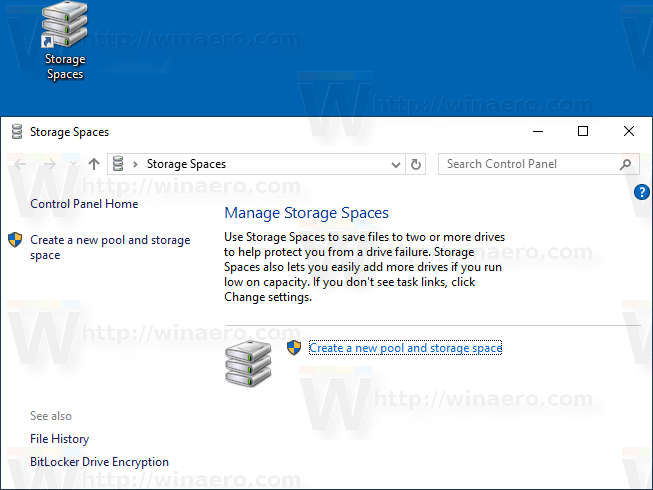Windows 10 version 2004 comes, May 2020 Update, comes with a bug that makes Storage Spaces unsuable and can cause data loss. Microsoft has published new instructions for affected users.

Storage Spaces helps protect your data from drive failures and extend storage over time as you add drives to your PC. You can use Storage Spaces to group two or more drives together in a storage pool and then use capacity from that pool to create virtual drives called storage spaces.
Advertisеment
Storage spaces typically store two copies of your data so if one of your drives fails, you still have an intact copy of your data. Also, if you run low on capacity, you can add more drives to the storage pool.
After upgrading to Windows 10 Version 2004, May 2020 update, some users are unable to access their Storage Spaces. Pools included in Storage Spaces display their drives as a RAW disk.
Devices using Storage Spaces might have issues using or accessing their Storage Spaces after updating to Windows 10, version 2004 (the May 2020 Update) and Windows Server, version 2004. When using some configurations, partition for Storage Spaces might show as RAW in Disk Manager.
Microsoft has provided the following solutions to resolve the situation.
- Select Start and type: troubleshoot
- Select Troubleshoot Settings
- Select View History in the Troubleshoot section of the Settings dialog.
- If the troubleshooter has attempted to run, you will see a critical troubleshooter or recommended troubleshooter with the title and description from the below table. The notes column explains what the troubleshooter does.
| Title | Description | Notes |
| Hardware and devices troubleshooter | Automatically change system settings to fix a problem on your device. | This troubleshooter will prevent issues with the data on your Storage Spaces. After the troubleshooter has run, you will not be able to write to your Storage Spaces. |
| Storage space troubleshooter | Data corruption was detected on your parity storage space. This troubleshooter takes actions to prevent further corruption. It also restores write access if the space was previously marked read-only. For more information and recommended actions please see the link below. | This troubleshooter will mitigate the issue for some users and will restore read and write access to your Parity Storage Spaces. Note Files that have already had issues may need to be recovered. See the "Recover files" section below for more information. |
Note When following the steps above on devices using Simple Storage Spaces or Mirror Storage Spaces, you might see a Could not be run message for the troubleshooter. This is expected as Simple Storage Spaces and Mirror Storage Spaces are not affected by this issue. The troubleshooter and steps below are not needed on these types of Storage Spaces. If you are using Parity Storage Spaces and receive a Could not be run message, then you might need to use the steps below.
If you are using Windows Server, version 2004 or the troubleshooter has not yet run, you can use the following instructions to mark them as read only:
- Select Start and type: powershell
- Right click or long press on Windows PowerShell and select Run as administrator.
- If prompted by a User Access Control dialog for Windows Powershell, select yes.
- Within the PowerShell dialog, type the following command and press enter:
Get-VirtualDisk | ? ResiliencySettingName -eq Parity | Get-Disk | Set-Disk -IsReadOnly $true - Your Storage Spaces should now be set to read only, meaning you will not be able to write to them. Your device will still be usable, and any volume not seen as RAW should be readable.
Note The above steps are the equivalent to the troubleshooter above titled Hardware and devices troubleshooter. There is currently no manual equivalent to the troubleshooter titled Storage space troubleshooter.
Recover files
If you are able to access your Parity Storage spaces and it does not show as RAW in Disk Manager, you can attempt recovery using WinFR and the steps below. For more information on how to use WinFR, see Recover lost files on Windows 10
- Download and run the tool from https://www.microsoft.com/store/apps/9N26S50LN705
- Run segment mode (
/r) with the undeleted files flag (/u) to recover files from your NTFS volumes. By default, this will recover all possible files. You can add filter flags if you are only interested in certain file formats (such as/n *.docx) and to reduce system file recovery. Example command to recover alldocxfiles present in theC:drive to theD:\SpacesRecoveryfolder:winfr.exe C: D:\SpacesRecovery /r /u /n*.docx - Once the command has completed, you can view the recovered files. In the above example, you would need to go to
D:\SpacesRecoveryto do so. If you encounter issues using WinFR, please contact winfr@microsoft.com.
If you have a ReFS volume that shows as RAW in Disk Manager, you can use the refsutil salvage command to recover data to a volume of equivalent size. There are two options for salvage command: quick and full. A quick recovery may not recover as much data as a full recovery.
To perform a quick recovery:
In an elevated command prompt: refsutil salvage -QA <source volume> <working directory> <target directory>
For example: refsutil salvage -QA E: F:\SalvagedFiles
To perform a full recovery:
In an elevated command prompt: refsutil salvage -FA <source volume> <working directory> <target directory>
For example: refsutil salvage -FA E: F:\SalvagedFiles
Support us
Winaero greatly relies on your support. You can help the site keep bringing you interesting and useful content and software by using these options:
